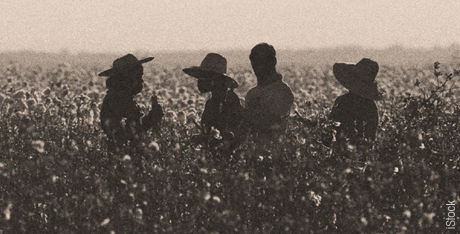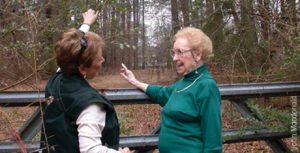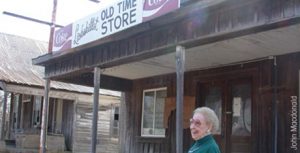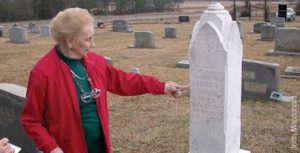My mother’s family homestead is at the leafy green intersection of Johns Road and Johns Gin Road, named for her people who farmed cotton and ginned it there.
They called it a plantation. But even in its heyday it wasn’t one of those gracious Gone With the Wind plantations that sprawled across the Civil War landscape of the South.
Rather, it was a large farm, a once-bustling presence in the rural heartland of Northwestern Louisiana, near Shreveport. Home was a comfortable single-story white house of wood perched atop brick stilts as tall as a man. Wide steps led to a shady veranda across the front. An open breezeway ran through the middle of the house, with bedrooms and sitting rooms on either side.
In the old days, the cookhouse was a separate building out back. The space under the main house was a commissary with packed dirt for a floor, where tobacco, food staples and quinine for malaria were once doled out to slaves, and, after the war, to those who continued to scratch out an existence in the fields.
Mom took me there a few years ago when I was going through one of those “where did I really come from?” periods. We didn’t know who owned the house now, so we peered through the trees from the side of the road as Mom talked about days gone by.
That homestead was the backdrop for stories that told Mom who she was and who her people were.
But today we are a society that moves often and discards easily. The lessons of home that the soul recognizes the values and moral compasses we inherit are perhaps more elusive for my generation and the ones that will follow.
Mom was 89 when she took me to the corner of Johns and Johns Gin Roads to share the memories of her girlhood. She never lived there (the place belonged to her aunt and uncle, not her parents), but she visited often and still recalled the smell of that commissary — all “dankness, snuff and medicines.”
After the Civil War, times were bad in the parishes of Northwestern Louisiana. The plantation wouldn’t support all the family. So the Johns boys — Mom’s father, John Bunyan, and his brother, Asa Dick were given a choice. One could go to college, and the other would inherit the plantation.
My grandfather chose education and proceeded to become a poor country doctor while his brother prospered on the farm.
My mother was one of eight siblings. Her given name was Alice, pronounced the French way (a-LEESE), a bow to the Cajun and Creole families who also settled the region.
The Johnses lived in a series of houses in nearby towns. When Mom was a girl, they lived in a sneeze-and-you-miss-it hamlet called Lickskillet (a hog-holler sounding name that was later changed to the more gentile Bethany).
Local lore insisted it was called Lickskillet “because after dinner they’d call in the old hound dogs to clean up the dishes,” Mom said. “I don’t think that’s true, but that’s what they said.”
Any time the other kids wanted to embarrass her, they said she came from Lickskillet, Mom told me, putting on that face that said I had best not go there.
I don’t have much from Mom’s side of my heritage — a flowery platter and an ugly green vase that Grandmother Johns handed down as heirlooms, the tiny diamonds from her wedding band I had made into a casual ring, and her love of crossword puzzles. That’s all — unless you count the repulsion I have for our family’s slave-owning history that I hope I inherited from my grandfather, the one who chose an education over a farm.
Even with this darker aspect of my family’s history, I’ve mostly thought of my ancestral roots as being sunk deep in the furrows of the Johnses’ cotton plantation.
But recently I’ve been thinking a lot about another family home that contributed to the core of my body and being. It was established in East Texas, not far from Lickskillet, by George Clinton McCoppin, an immigrant great-grandfather on my dad’s side.
We know something about George, but not much.
He came to America from Ireland in 1835, when he was just 15, with two older brothers. He settled in Mississippi, married Rebecca Washington there, and moved on to Texas about the time of the Civil War. He fought at Vicksburg on the losing side. Family tradition says he traded a sweater knitted by Rebecca for a horse to ride back home afterward.
We have no idea where he was born in Ireland or why the brothers left for America. We don’t know why they separated at some point, forever, leaving my great-grandfather to grow up on his own and become whatever he might. We don’t know where the other brothers went.
George belonged to the Masons, and my family has the soft, white leather Masonic apron decorated with black-and-white symbols he wore as a member of that secret society.
I inherited nothing else of his.
I have nurtured for years a romantic but despairing vision of George’s story, of his and my ancestral home in Ireland.
It features a mother weeping at the doorway of a thatched-roof cottage either in anguish because her boys were leaving home and she most assuredly would never see them again or in sad relief because that would be three fewer boys to compete for too few potatoes.
I don’t know if any of that would ring true in my ancestors’ ears. But I am planning a “roots trip” to Ireland before long to see our homeland for myself.
All my efforts have so far led nowhere. Apparently, there are no people by that name still in Ireland. And no easily found account of George Clinton McCoppin’s birth. My best bet, it seems, is to pore through the records of the thousands of Irish churches, any of which might harbor the fact of his birth.
The genealogist suggested the family may have lived in Longford County, in Central Ireland. There were families named McCoppin there in the past, and some of their given names were the same as in my family.
So I will go to Longford.
I won’t be seeking a tangible homestead there. No point in that.
I may long for roots and home as part of this on-the-move society I live in. But such permanence can be elusive, a fading memory of bits and pieces of whatever came before.
No house will be there in Ireland to help bring me clarity.
I do hope to find in the green countryside of Longford a match to the green at the junction of Johns and Johns Gin Roads. And I think I’ll recognize “home” in the heart of who I am, a fitting link between the Johnses of America and the McCoppins of Ireland.






